Which country will host the World’s First International Controlled Bank of low-enriched Uranium?
(a) Russia
(b) Kazakhstan
(c) Turkmenistan
(d) Australia
Answer: (b)
Explanation:
The International Atomic Energy Agency (IAEA) and Kazakhstan signed an agreement on Aug 27, 2015 to locate the first internationally-controlled bank of low-enriched uranium in the ex-Soviet nation to ensure fuel supplies for power stations and prevent nuclear proliferation.
The storage facility, set to become fully operational in 2017, is intended to provide IAEA member states with confidence in a steady and predictable supply of fuel even if other routes are disrupted.
The IAEA estimates the cost of the bank at $150 million, which includes the procurement of low-enriched uranium (LEU) and its work for the first 10 years.
The bank will contain up to 90 metric tons of LEU, sufficient to run a 1,000 MWe (megawatt electric) light-water reactor
The bank will be located at the Ulba Metallurgical Plant in the northeastern industrial city of Ust-Kamenogorsk. The plant has handled and stored nuclear material, including LEU, safely and securely for more than 60 years
After the collapse of the Soviet Union, Kazakhstan voluntarily gave up its nuclear arsenal, the world’s fourth-largest at the time.
The mineral-rich Central Asian nation of 17.5 million is the world’s largest uranium producer and holds more than 15 percent of global uranium reserves, second only to Australia. It has no nuclear power stations of its own.
The World’s largest producer of Uranium is:
(a).Australia
(b).Canada
(c).South Africa
(d).None of these
Answer: (d)
Explanation:
At one time Canada was the largest uranium producer in the world, but it lost that place to Kazakhstan in 2009.
Which of the following states has not ratified the Comprehensive Test Ban Treaty (CTBT)?
(a) Canada.
(b) France
(c) United States
(d) None of these.
Answer: (c)
Explanation:
The Comprehensive Test Ban Treaty (CTBT) was designed to prevent testing of nuclear weapons and hence reduce the chance of an arms race.October 13, 1999, the US Senate decided not to ratify the CTBT. This drew condemnation from Bill Clinton and the White House Administration, environmental groups and other governments. The grounds for rejection (ignoring the bipartisan politics that some claim affected this decision) was that if the US ratified this treaty, it would not stop others trying to go nuclear and therefore the US should not ratify on the grounds of national security.
Despite over 10 years of global efforts to promote the entry into force of the Comprehensive Test Ban Treaty (CTBT), the treaty’s enactment appears a long way off.
President George H. W. Bush signed into law the unilateral declaration to forego full-scale nuclear weapons testing October 2, 1992. The United States signed the CTBT on September 24, 1996, the day it opened for signature, but the Senate dealt a severe blow to the near-term prospects for U.S. participation when it refused to provide its advice and consent October 13, 1999. President Obama, however, stated in February 2009 that he intends to pursue Senate ratification of the treaty “immediately and aggressively.”
The CTBT will formally enter into force after 44 designated “nuclear-capable states” have deposited their instruments of ratification with the UN secretary-general. To date, 183 states have signed and 159 have ratified the treaty. Yet of the 44 specified countries, India, Pakistan, and North Korea still have not signed, and only 36 have ratified the treaty.
The following chart identifies the treaty’s signatories and ratifiers as of April 2013. States whose ratification is required for the treaty to take effect are shaded and marked with an asterisk (*).
What is the name of the upgraded version of China’s 10,000-km range missile which was successfully tested recently?
Which country is the biggest producer of uranium in the world?
(a)France
(b) South Africa
(c) Canada
(d) None of these
Answer: (d)
Explanation:
Kazakhstan has 19% of world reserves of the mineral and is the largest producer. It’s biggest customers are Russia, India, China and Japan to cover the future needs also. But Kazakhstan wants to transform itself from provider of raw materials to energy producer. Canada was the world’s largest uranium producer for many years, accounting for about 22% of world output, but in 2009 was overtaken by Kazakhstan.
The place at which Indian and Pakistani armies held Brigade Commander-level flag meeting
(a) Muzafarabad
(b) Chakan-Da-Bagh (Poonch)
(c) Mir Pur
(d) None of these
Answer: (b)
Explanation:
The Pakistani and Indian armies was held Brigade Commander-level flag meeting at Chakan-Da-Bagh in Poonch district in Jammu and Kashmir on 14 January 2013. The objective of the meeting was to de-escalate tension along the Line of Control and border.
Nobel Peace Prize for the year 2005 was awarded to M. Elbardei together with:
(a)United Nations Educational Scientific and Cultural Organization (UNESCO)
(b) International Atomic Energy Agency (IAEA)
(c) World Health Organization (WHO)
(d) None of these
Answer: (b)
Explanation:
ElBaradei and the IAEA were jointly awarded the Nobel Peace Prize in 2005. The 2016 Nobel Peace Prize was awarded to the President of Colombia Juan Manuel Santos “for his resolute efforts to bring the country’s more than 50-year-long civil war to an end”
Which country is the biggest producer of uranium in the world?
(a) France
(b) South Africa
(c) Canada
(d) None of these
Answer: (d)
Explanation:
Kazakhstan is the world’s leading producer of uranium. The country has steadily rose in production since 2009 through to 2015, with 39 percent of world production last year. In 2015, Kazakhstan produced 23,800 tones, which is a significant leap from 2014’s 23,127 tones. The country’s government is planning to build a Russian nuclear power reactor, possibly at Kurchatov, by 2025. Kazakhstan holds 12 percent of the world’s uranium resources with an expanding mine sector and is planning to increase that by 2018.
Kazakhstan produces the largest share of uranium from mines (39% of world supply from mines in 2015), followed by Canada (22%) and Australia (9%).
Which of the following states has not ratified the Comprehensive Test Ban Treaty (CTBT)?
(a) Canada.
(b) France
(c) United States
(d) None of these.
Answer: (c)
Explanation:
The United States signed the CTBT on September 24, 1996, the day it opened for signature, but the Senate dealt a severe blow to the near-term prospects for U.S. participation when it refused to provide its advice and consent October 13, 1999. President Obama, however, stated in February 2009 that he intends to pursue Senate advice and consent to ratification of the treaty “immediately and aggressively.”
On 4 March, Niue became the 162nd nation to ratify the CTBT. It signed the treaty on 9 April 2012.
Total Signatories: 183
Total Ratifiers: 166
Annex 2 Ratifications (out of 44): 36
Where is the headquarters of the European Organization for Nuclear Research (CERN)?
(a) Geneva
(b) Berlin
(c) Washington
(d) New York
Answer: (a)
View our Complete Range of International Relations MCQs for CSS
- MCQs on the Shanghai Cooperation Organisation (SCO)
- International Organizations MCQs | General Knowledge MCQs
- International Relations MCQs (International political community Se-II)
- International Relations MCQs | Contemporary Issues
- International Relations MCQs | Weapons of Mass Destruction MCQs
- International Relations MCQs | South Asia MCQs Solved
- International Relations MCQs | Foreign Policy of Selected Countries MCQs
- International Relations MCQs | International and Regional Organizations MCQs
- International Relations MCQs | Post Cold War Solved MCQs
- International Relations MCQs (Cold War) Solved with Explanation

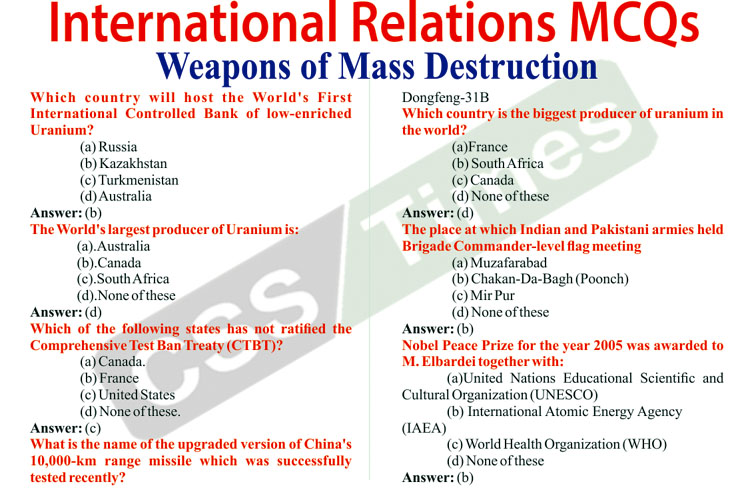
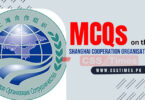
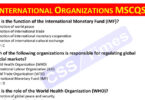
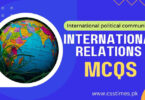
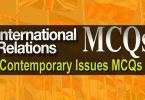

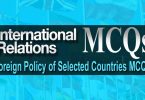
[…] Read also: International Relations MCQs | Weapons of Mass Destruction MCQs […]
[…] Read also: International Relations MCQs | Weapons of Mass Destruction MCQs […]